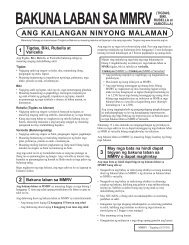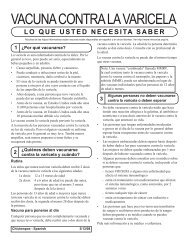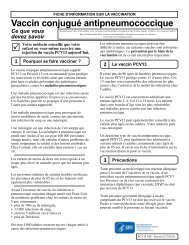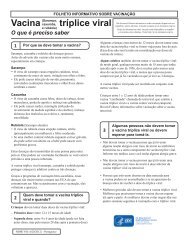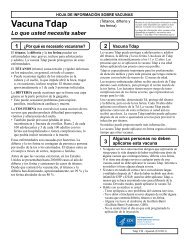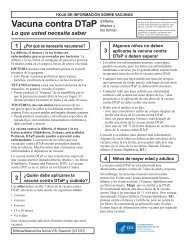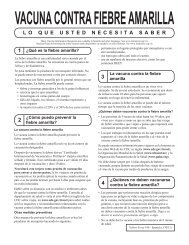AOV Guide Step 2: Setting Up for Vaccination Services
AOV Guide Step 2: Setting Up for Vaccination Services
AOV Guide Step 2: Setting Up for Vaccination Services
You also want an ePaper? Increase the reach of your titles
YUMPU automatically turns print PDFs into web optimized ePapers that Google loves.
<strong>Step</strong> 2: <strong>Setting</strong> <strong>Up</strong> <strong>for</strong> <strong>Vaccination</strong> <strong>Services</strong><br />
If we could send out a prefabricated “vaccination station” filled<br />
with inventory that you could simply install in (or add onto)<br />
your practice (modeled after Edward Jenner’s fieldstone smallpox<br />
vaccination cottage in England, of course!), we would. But<br />
this chapter is the next best thing. It gives a lot of in<strong>for</strong>mation<br />
about a lot of details all in one place. It will help you to prepare<br />
your facility and your personnel <strong>for</strong> the great preventive health<br />
care service you are soon going to be providing. Maybe some<br />
health settings that already offer one or two vaccines can skip<br />
this in<strong>for</strong>mation, but if you are brand new to vaccinating, following<br />
this chapter’s footprints will save you some time, frustration,<br />
and possibly a little money. Most of the supplies you will need<br />
come from just a few different sources. Someone will have to<br />
decide where the new supplies will be stored, who will use and<br />
maintain what, and when your setting will be ready to begin<br />
vaccinating. To keep things in perspective, just remember: you<br />
are simply adding a new and important service, not revamping<br />
or restructuring your entire setting.<br />
<strong>Step</strong>-by-<strong>Step</strong><br />
<strong>Setting</strong> <strong>Up</strong> Tasks<br />
• Obtain support and cooperation from clinic staff<br />
• Seek out community resources<br />
• Assign a vaccination coordinator<br />
• Plan workflow and workspace<br />
• Purchase vaccine storage equipment<br />
• Purchase vaccine administration supplies<br />
• Purchase emergency response supplies<br />
• Arrange <strong>for</strong> staff training<br />
• Organize other vaccination paperwork and<br />
reference materials<br />
• Create standing orders documents<br />
• Order vaccines — yes, do this last!
Page 12<br />
<strong>Step</strong> 2: <strong>Setting</strong> <strong>Up</strong> <strong>for</strong> <strong>Vaccination</strong> <strong>Services</strong><br />
Obtain support and cooperation from clinic staff<br />
How you integrate a new activity into your already busy set of<br />
responsibilities will be tricky. You know it’s the right thing to do,<br />
but you’re going to need to convince others in your clinic or<br />
agency. A combination of meetings and follow-up written communications<br />
can be effective in gaining support and making<br />
certain everyone gets the same in<strong>for</strong>mation. Frontline staff, both<br />
medical and clerical, will likely be the most heavily impacted and<br />
will need to receive a lot of positive rein<strong>for</strong>cement that this is,<br />
indeed, a worthwhile and important service. As soon as possible,<br />
representatives from each group (management, financial, insurance,<br />
clinical, nursing, clerical, etc.) should become involved in<br />
working meetings to discuss issues such as:<br />
• Will all patients or clients be offered vaccine, or<br />
only a select high-risk group?<br />
• Will vaccines be offered every day or only during<br />
designated times?<br />
Materials<br />
<strong>for</strong> you<br />
to use<br />
• Suggested Supplies Checklist <strong>for</strong> Adult Immunization<br />
Clinic (75)<br />
• Standing Orders <strong>for</strong> Administering Hepatitis A Vaccine (76)<br />
• Standing Orders <strong>for</strong> Administering Hepatitis B Vaccine (77)<br />
• Standing Orders <strong>for</strong> Administering Influenza Vaccine (78)<br />
• Standing Orders <strong>for</strong> Administering MMR Vaccine (79)<br />
• Standing Orders <strong>for</strong> Administering Meningococcal<br />
Vaccine (80)<br />
• Standing Orders <strong>for</strong> Administering Pneumococcal<br />
Vaccine (81)<br />
• Standing Orders <strong>for</strong> Administering Tetanus-Diphtheria<br />
Vaccine (82)<br />
• Standing Orders <strong>for</strong> Administering Varicella Vaccine (83)<br />
• Vaccines and Related Biologics Distributed in the U.S., 2003<br />
(86)<br />
Adults Only <strong>Vaccination</strong>: A <strong>Step</strong>-by-<strong>Step</strong> <strong>Guide</strong> Immunization Action Coalition www.immunize.org www.vaccinein<strong>for</strong>mation.org
<strong>Step</strong> 2: <strong>Setting</strong> <strong>Up</strong> <strong>for</strong> <strong>Vaccination</strong> <strong>Services</strong><br />
Page 13<br />
• What paperwork is necessary <strong>for</strong> this activity?<br />
• Who is responsible <strong>for</strong> tracking vaccine usage?<br />
• How will tracking be done?<br />
• Can patients/clients come in <strong>for</strong> vaccination only,<br />
or will vaccination occur as a secondary purpose<br />
at a visit?<br />
Seek out community resources<br />
Once you have a basic idea of how and whom you’d like to<br />
vaccinate in your clinic/facility, it’s time to seek out expertise<br />
from others within your setting or from outside sources. If you’re<br />
already part of a large medical facility, you can always learn<br />
from those who are involved in routine vaccinations (e.g., pediatricians,<br />
family physicians, internists, nurse clinicians). But if<br />
you’re not part of a large organization with experienced vaccinators<br />
to help you, contact staff at your local or state health department.<br />
A list of names and phone numbers <strong>for</strong> staff at state<br />
health departments can be found on our website at<br />
www.immunize.org/coordinators<br />
Assign a vaccination coordinator<br />
Most likely, you will not need to hire new staff to set up or<br />
administer your vaccination program. But someone should be<br />
the designated vaccination coordinator. It’s important, too, to<br />
assign someone to be the back-up person to the coordinator. The<br />
coordinator will have responsibility <strong>for</strong> ordering and maintaining<br />
an inventory of vaccines, syringes, and other supplies; developing<br />
or acquiring medical protocols <strong>for</strong> vaccinators and assuring<br />
competence of staff; ensuring proper storage of the vaccine;<br />
monitoring compliance with several recordkeeping requirements;<br />
and evaluating the program. That person and the back-up person<br />
will read through the rest of this guide!<br />
Adults Only <strong>Vaccination</strong>: A <strong>Step</strong>-by-<strong>Step</strong> <strong>Guide</strong> Immunization Action Coalition www.immunize.org www.vaccinein<strong>for</strong>mation.org
Page 14<br />
<strong>Step</strong> 2: <strong>Setting</strong> <strong>Up</strong> <strong>for</strong> <strong>Vaccination</strong> <strong>Services</strong><br />
Plan workflow and workspace<br />
Decide in advance where the vaccinations will actually take<br />
place. Plan <strong>for</strong> a waiting area and a vaccination area. Make sure<br />
there is good lighting and ventilation, a sink <strong>for</strong> handwashing,<br />
and telephone access. Consider where you will prepare and draw<br />
the syringes with vaccine. Make certain that there is adequate<br />
space to place sharps containers (<strong>for</strong> used needles) close to<br />
where the vaccinations will be administered. Is there space <strong>for</strong><br />
an additional refrigerator and freezer unit if needed? A cupboard<br />
<strong>for</strong> storing everything from needles to alcohol wipes? What<br />
about shelf space and slots or trays <strong>for</strong> <strong>for</strong>ms, in<strong>for</strong>mational<br />
materials, and record cards?<br />
Purchase vaccine storage equipment<br />
You will need a dedicated refrigerator-and-freezer unit <strong>for</strong> your<br />
vaccines, one that will not be used <strong>for</strong> any purpose or product<br />
beyond the storage of pharmaceuticals and biological products.<br />
(That means no staff lunches or beverages—aside from contamination<br />
issues, frequent opening and closing of the doors should<br />
be avoided to help maintain constant temperatures. See <strong>Step</strong> 3<br />
<strong>for</strong> details on handling and storage of vaccines.) This appliance<br />
does not have to come from a medical supply company. You can<br />
buy one from a local department or appliance store, or you can<br />
order one from a national brand company.<br />
An important factor in purchasing a unit is to get one with separate<br />
freezer and refrigerator compartments, meaning that the<br />
compartments have different doors. The “dormitory-style” models<br />
with one door <strong>for</strong> both compartments is not acceptable,<br />
because the freezer does not stay cold enough. However, if you<br />
will not be administering varicella vaccine, you could get by<br />
without the separate freezer unit.<br />
Adults Only <strong>Vaccination</strong>: A <strong>Step</strong>-by-<strong>Step</strong> <strong>Guide</strong> Immunization Action Coalition www.immunize.org www.vaccinein<strong>for</strong>mation.org
<strong>Step</strong> 2: <strong>Setting</strong> <strong>Up</strong> <strong>for</strong> <strong>Vaccination</strong> <strong>Services</strong><br />
Page 15<br />
To make sure the refrigerator and freezer are functioning properly,<br />
you also will need to invest in a good set of thermometers<br />
<strong>for</strong> keeping track of temperatures in the refrigerator and freezer.<br />
(You will need two—one <strong>for</strong> each compartment.) Newer, hightech<br />
thermometers will actually alert you when temperatures go<br />
outside the accepted range <strong>for</strong> vaccines (again, details can be<br />
found in <strong>Step</strong> 3, but <strong>for</strong> now be aware that someone must monitor<br />
temperatures at least twice a day).<br />
Purchase vaccine administration supplies<br />
Depending on what other activities your clinic or setting already<br />
per<strong>for</strong>ms, you may have many of the necessary items. For<br />
instance, if you already give shots, you will have syringes,<br />
needles, and a sharps container <strong>for</strong> used needles. But <strong>for</strong> the<br />
sake of thoroughness, we have devised and enclosed a “Suggested<br />
Supplies Checklist <strong>for</strong> Adult Immunization Clinic” <strong>for</strong><br />
your use as an inventory tracker (see page 75). When an item<br />
runs low, mark it or circle it on a copy of the checklist <strong>for</strong> the<br />
next time an order is made. You will also need to purchase one<br />
service: medical waste disposal <strong>for</strong> your used syringes and<br />
needles. If you’re not part of a medical setting that already deals<br />
with this issue, consult local medical waste-disposal companies<br />
<strong>for</strong> options and prices.<br />
In subsequent chapters, you will learn in more detail how and<br />
why some of the supplies on the checklist are going to be used.<br />
Many of them will be self-explanatory. They are listed here all in<br />
one place simply so you can be sure to obtain them be<strong>for</strong>e you<br />
begin vaccinating.<br />
Adults Only <strong>Vaccination</strong>: A <strong>Step</strong>-by-<strong>Step</strong> <strong>Guide</strong> Immunization Action Coalition www.immunize.org www.vaccinein<strong>for</strong>mation.org
Page 16<br />
<strong>Step</strong> 2: <strong>Setting</strong> <strong>Up</strong> <strong>for</strong> <strong>Vaccination</strong> <strong>Services</strong><br />
Purchase emergency response supplies<br />
Toward the end of <strong>Step</strong> 5 on administering vaccines, you will<br />
learn what you need to do to handle anaphylactic (allergic)<br />
reactions to vaccines, though they are extremely rare. You absolutely<br />
must have these emergency provisions on hand just in<br />
case. Refer again to the checklist on page 75.<br />
Arrange <strong>for</strong> staff training<br />
In addition to orienting your staff to the overall purpose, function,<br />
and flow of the vaccination clinic, you will want to assure<br />
competency of clinic staff in administering immunizations. Your<br />
state or local health department may be able to provide such<br />
training or can refer you to other resources—or perhaps you<br />
have well-trained individuals who work in a different part of<br />
your organization. Check out the available videos that we have<br />
provided with this guide along with their presenter’s notes. “<strong>Step</strong><br />
5: Administering Vaccines” in this guide covers basic points but is<br />
no substitute <strong>for</strong> live instruction.<br />
Organize other vaccination paperwork<br />
and reference materials<br />
This guide provides you with some of the most important <strong>for</strong>ms<br />
you are going to use in your vaccination practice: “Vaccine<br />
In<strong>for</strong>mation Statements” (VISs), wallet-sized foldable immunization<br />
record cards <strong>for</strong> patients to keep, patient screening questionnaires,<br />
refrigerator temperature logs, “Vaccine Adverse Event<br />
Reporting System” (VAERS) <strong>for</strong>ms, and others.<br />
Again, here we just want you to be aware that there will be<br />
Adults Only <strong>Vaccination</strong>: A <strong>Step</strong>-by-<strong>Step</strong> <strong>Guide</strong> Immunization Action Coalition www.immunize.org www.vaccinein<strong>for</strong>mation.org
<strong>Step</strong> 2: <strong>Setting</strong> <strong>Up</strong> <strong>for</strong> <strong>Vaccination</strong> <strong>Services</strong><br />
Page 17<br />
required <strong>for</strong>ms and documents so you can think about how you<br />
will organize them. Most of the <strong>for</strong>ms and charts themselves will<br />
appear in the chapters in which they are fully discussed or in the<br />
Resources section at the end of this guide. You will need to keep<br />
copies of the appropriate VISs in a convenient location. You will<br />
also want to have other patient educational materials in wall<br />
racks or drawers in the vaccination/exam rooms along with<br />
screening and assessing questionnaires <strong>for</strong> patients to fill out<br />
(unless you find that the waiting room is a better place and time<br />
<strong>for</strong> them to do that). Finally, you will need billing <strong>for</strong>ms close at<br />
hand.<br />
One good system is to have a centralized file of vaccinationrelated<br />
masters, or originals, and then keep copies in stackable<br />
file slots, plastic wall pockets, accordion-style files, or in colored<br />
folders—whatever works <strong>for</strong> your setting—in the rooms where<br />
they will be used.<br />
Create standing orders documents<br />
This is a simple but powerful step. You now are getting most of<br />
the “physical stuff” in place <strong>for</strong> your vaccination practice. But<br />
you also need to know who is going to be doing the vaccinating.<br />
Unless you always have a physician onsite and accessible to<br />
order vaccines <strong>for</strong> individual patients, you may need standing<br />
orders that permit a nurse or other approved licensed practitioner<br />
to administer vaccines when a physician is not present.<br />
Who this person can and cannot be and the credentials required<br />
differs by state. If you’re unsure, contact your state health<br />
department or department of professional regulation <strong>for</strong> in<strong>for</strong>mation<br />
on who can be authorized to administer vaccinations<br />
when a physician is not onsite.<br />
Adults Only <strong>Vaccination</strong>: A <strong>Step</strong>-by-<strong>Step</strong> <strong>Guide</strong> Immunization Action Coalition www.immunize.org www.vaccinein<strong>for</strong>mation.org
Page 18<br />
<strong>Step</strong> 2: <strong>Setting</strong> <strong>Up</strong> <strong>for</strong> <strong>Vaccination</strong> <strong>Services</strong><br />
In countless studies, it has been found one of the best ways to<br />
increase adult immunization is the implementation of standing<br />
orders. All this means is that a doctor writes a sort of blanket<br />
order <strong>for</strong> an authorized person to administer a given vaccine to<br />
patients with certain indications after screening <strong>for</strong> contraindications.<br />
Usually a nurse, the authorized vaccinator does not need<br />
to get explicit permission from a doctor to screen and vaccinate<br />
each patient who comes in. He or she, working under the<br />
doctor’s order, conducts a vaccination review. In fact, often the<br />
standing orders to vaccinate become part of routine patient-care<br />
clinic procedure—just like documenting weight and blood pressure—so<br />
that vaccination status and needs are checked every<br />
time a patient enters the clinic. This greatly reduces the likelihood<br />
that a patient will fall through the cracks and miss an<br />
opportunity to be vaccinated.<br />
Standing orders were given a big boost by a report issued in<br />
early 2000 by the Centers <strong>for</strong> Disease Control and Prevention’s<br />
Advisory Committee on Immunization Practices (ACIP) titled<br />
“Use of Standing Orders Programs to Increase Adult <strong>Vaccination</strong><br />
Rates” (MMWR [Vol. 49: RR-1] March 24, 2000). In this report,<br />
ACIP stated that the committee “recommends prioritizing these<br />
[standing orders] programs <strong>for</strong> influenza and pneumococcal<br />
vaccinations, to have the greatest impact on the burden of vaccine-preventable<br />
diseases in the United States. Standing orders<br />
programs are also recommended <strong>for</strong> other vaccines, including<br />
hepatitis B vaccine and diphtheria and tetanus toxoid vaccines,<br />
when feasible.” The ACIP report concluded by encouraging “the<br />
introduction of standing orders programs <strong>for</strong> vaccination of<br />
adults in other settings (e.g., inpatient and outpatient facilities,<br />
managed-care organizations, assisted living facilities, correctional<br />
facilities, pharmacies, adult workplaces, and home healthcare<br />
agencies).”<br />
Adults Only <strong>Vaccination</strong>: A <strong>Step</strong>-by-<strong>Step</strong> <strong>Guide</strong> Immunization Action Coalition www.immunize.org www.vaccinein<strong>for</strong>mation.org
<strong>Step</strong> 2: <strong>Setting</strong> <strong>Up</strong> <strong>for</strong> <strong>Vaccination</strong> <strong>Services</strong><br />
Page 19<br />
Signed copies of the standing orders must be kept on file within<br />
your practice. It’s primarily an internal, working document; that<br />
is, standing orders do not need to be registered with a state<br />
agency.<br />
For vaccination purposes, you should have standing orders not<br />
only <strong>for</strong> administering vaccines, but also <strong>for</strong> the management of<br />
vaccine reactions (see <strong>Step</strong> 5).<br />
Sample standing orders documents, as well as a protocol <strong>for</strong><br />
managing vaccine reactions, can be found on pages 76–85 in<br />
Appendix A.<br />
Order vaccines—yes, do this last!<br />
When the stage has been set and all the props are in place, it’s<br />
time to bring on the main actors, the vaccines. (Why shouldn’t<br />
you order them be<strong>for</strong>e you are completely ready? They are, as<br />
you will see, somewhat expensive, and while they have fairly<br />
long shelf lives, they don’t last <strong>for</strong>ever and they are fragile.) By<br />
now, you have tested the refrigerator and/or freezer temperatures<br />
<strong>for</strong> a week or more to make sure the appliance(s)<br />
function(s) properly. You have all the injection supplies and<br />
copies of <strong>for</strong>ms that you will need. So go ahead and order your<br />
vaccines. It’s easy.<br />
Vaccines can be purchased from a number of different places.<br />
You can order them directly from vaccine companies; you can<br />
order them from pharmaceutical supply companies (the ones<br />
that also sell you other medical supplies); you might be able to<br />
order them through your parent institution (your university if<br />
you are part of one, your health plan if you are affiliated with<br />
one); or you might be able to obtain certain vaccines from your<br />
state or local health department, both of which sometimes stock<br />
Adults Only <strong>Vaccination</strong>: A <strong>Step</strong>-by-<strong>Step</strong> <strong>Guide</strong> Immunization Action Coalition www.immunize.org www.vaccinein<strong>for</strong>mation.org
Page 20<br />
<strong>Step</strong> 2: <strong>Setting</strong> <strong>Up</strong> <strong>for</strong> <strong>Vaccination</strong> <strong>Services</strong><br />
supplies <strong>for</strong> high-risk people or the settings that serve them.<br />
Most vaccines are provided in single-dose units that may or may<br />
not come as prefilled syringes. For a complete list of all products<br />
used with both children and adults, see “Vaccines and Related<br />
Biologics Distributed in the U.S.” on page 86. This resource also<br />
lists the manufacturers if you want to order your vaccines<br />
directly from the pharmaceutical companies. But perhaps you<br />
want to continue to work with the same medical supply company<br />
that supplies your medications and other related products.<br />
If you plan to offer hepatitis B vaccination, hepatitis B vaccine<br />
can be available from a variety of sources. (Sometimes Td vaccine<br />
is available through these, as well.) State health departments<br />
receive vaccine from the Centers <strong>for</strong> Disease Control and<br />
Prevention (CDC) as part of a federal grant program, and some<br />
are now offering hepatitis B vaccine to correctional institutions,<br />
STD clinics, and other venues <strong>for</strong> use with high-risk adult<br />
patients. Be sure to talk to your state health department about<br />
possible supplies of (or funding <strong>for</strong>) hepatitis B vaccine <strong>for</strong> highrisk<br />
people. If they can’t assist you this year, they may be able to<br />
include your request in the department’s annual grant application<br />
to CDC <strong>for</strong> the following year. In addition, states can go to<br />
their legislatures and request special support <strong>for</strong> projects such as<br />
high-risk adult immunization in specific populations. This could<br />
help you to provide low-cost or free vaccinations.<br />
Congratulations! You are reading this guide, you’ve come this<br />
far—you are officially over the hump. If more settings like yours<br />
did this preparation and planning, we would see many fewer<br />
missed opportunities <strong>for</strong> vaccinating adults and much higher<br />
vaccination coverage rates. We would eventually see less preventable<br />
disease and death. It really does happen one clinic at a<br />
time and one vaccination at a time.<br />
Adults Only <strong>Vaccination</strong>: A <strong>Step</strong>-by-<strong>Step</strong> <strong>Guide</strong> Immunization Action Coalition www.immunize.org www.vaccinein<strong>for</strong>mation.org




